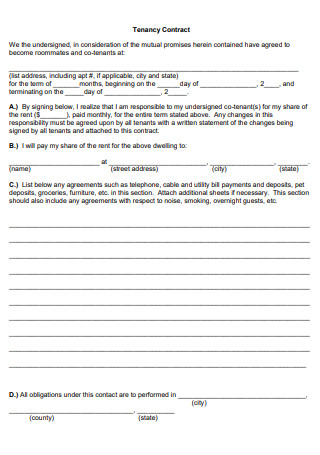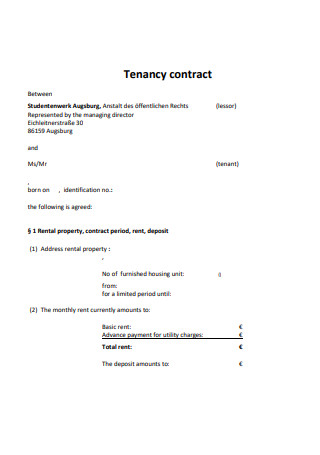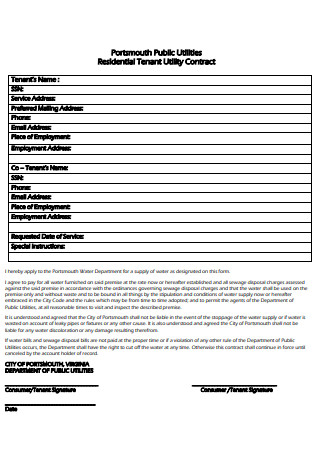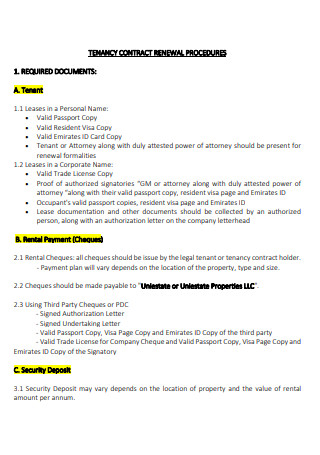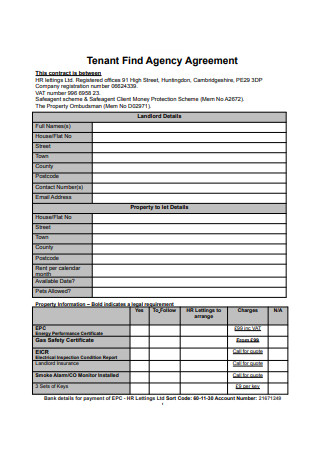4+ Sample Tenancy Contract
FREE Tenancy Contract s to Download
4+ Sample Tenancy Contract
What Is a Tenancy Contract?
What Is the Use of Tenancy Contract?
What Are Some Guidelines in Tenancy Contract?
Tips for Tenancy
How to Create a Tenancy Contract
FAQs
Do You Need a Copy of a Tenancy Agreement?
Tenancy Agreements Are Legally Enforceable Contracts, but What About Non-Exclusive Lease Agreements?
Do You Offer a Tenancy Agreement to Tenants?
A business in the rental property market can be both demanding and rewarding, especially when the company is performing at its best. A property owner should think about a variety of factors before putting his or her property up for rent, and one of those considerations should be the implementation of a screening process. This is where a tenancy agreement can be really beneficial. According to Forbes, the vast majority of experienced landlords have a variety of tenant horror stories to share with you. You may rest assured that these issues will not arise if you use a secure screening mechanism, such as a tenancy or Lease Agreement, to protect yourself. What exactly is a tenancy agreement, and why is it so necessary to have one? Take a look at the post below!
What Is a Tenancy Contract?
It is necessary to have a documented agreement or contract between you and the owner of the property you wish to rent out. This document, which is prepared by landlords, real estate experts, and renters, is a very significant part of the process of recording real estate transactions. The type of tenancy agreement you choose (written or oral) will depend on your needs and expectations. A tenancy agreement is prepared to protect the interests of both tenants and landlords in the event of a vacancy in an apartment building. We are providing you with many Tenancy Agreement Templates in order to aid you in putting together your own Tenancy Agreement as quickly as possible. As a tenant, you have the right to occupy the property for which you are responsible for payment to the landlord, and the landlord or owner of the property has the right to obtain payment in a legal manner. The term “terms and conditions of tenancy agreement” refers to whatever you put in a contract that is written down.
Tenancy agreements are extremely significant since they serve as legal documentation for all real estate and property-related transactions with renters that you enter into with them. Written rental agreements are simpler to enforce than oral agreements, therefore you should consider establishing a professional leasing agreement if you want to be as handy as possible while also addressing the property’s needs. Your tenancy agreement contains critical information, and you must be aware of this information before signing it. Other templates are available on our website, and you can use them whenever you need them. They are as follows: contract agreement, simple tenancy agreement, landlord rental agreement, residential tenancy agreement, house lease agreement, free room rental, land lease agreement, shareholder agreement, business lease agreement, shorthold tenancy agreement, and other similar templates are available. This post will not only provide you with templates but will also provide you with important information that you need to know in order to complete your template.
What Is the Use of Tenancy Contract?
It is necessary to have a tenancy agreement in order to develop an understanding between the landlord and the tenant that is legally binding. This is done in order to avoid any unintended consequences that may develop during the process. It is used to record the type of tenancy being given, the time period during which the rent is to be paid, who is responsible for repairing and decorating the property, the conditions under which the lease can be terminated, and a variety of other significant considerations. In rare situations, the tenancy agreement may also cover the problem of subletting any part of the building, as well as other issues such as keeping pets and maintaining gardens. It is broad enough for both landlords and tenants to use in their respective transactions, and it is easy to customize.
What Are Some Guidelines in Tenancy Contract?
In order for this agreement to appear professional, convenient, and functional, you must include all of the following terms and conditions in your tenancy agreement: The tenancy agreement shall be deemed incomplete and unenforceable if any of these terms and conditions are not met. The right format for writing a tenancy agreement can alternatively be described as follows: A few expert recommendations are provided below to assist you in creating an effective tenancy agreement:
- Your name, address, and complete contact information are required by the tenancy agreement, and the same information is required by the landlord in order to finish a very crucial component of this contract.
- It is also necessary to include important information regarding the property or housing in the rental contract. This information covers the location of the accommodation, the radius of the accommodation, and other relevant information about the different sections
- This must be completed in writing and include the length of the contract. In this case, both tenants and landlords should be aware of the facts.
- It is necessary to specify in the tenancy contract for what purpose the property will be used. The property may be required for a variety of purposes, such as housing, an office space, a factory, or a warehouse.
- It is necessary to provide the date of the tenancy agreement or contact information in the tenancy contract.
- Tenancy contracts must be written with the amount of rent that has been agreed upon. There may be further deductions that you will need to make in this interaction depending on the circumstances and conditions.
- If you want to use your tenancy agreement as legal proof, you must include all of the additional explicit and implicit terms and conditions as well.
- A clear statement in the leasing agreement must state whether the landlord is willing to supply you with any additional services such as maintenance, laundry, cleaning, and so on.
- Whether or not other persons are permitted to use the property must be specified in the tenancy agreement. Obtaining permission from the landlord is required before completing this task.
- It is necessary for both parties, namely tenants and landlords, to sign the tenancy agreement.
Tips for Tenancy
The process of looking for an apartment is already time-consuming, what with all of the labor it takes to go around and check out houses that are available for lease. Perhaps there is no need for concern. Given enough time, apartment or commercial space rentals are extremely common, and you would have a plethora of options to choose from, especially if you work with a professional, such as an agent, to ensure that you get the one you want at the best possible price and terms.
How to Create a Tenancy Contract
Tenancy agreements must be in writing, and the landlord must provide the tenant with a copy of the agreement before the tenancy can begin. Although there is no formal agreement in writing, even if there isn’t one, the Residential Tenancies Act 1986 (the Act) continues to apply. Landlords and tenants can’t get out of their duties by failing to put their agreement in writing in the first place. Before signing the leasing agreement, tenants should take the time to carefully study it. This document contains all of the terms and conditions. If there is anything they are unsure about, they should seek professional assistance before signing.
Step 1: Fill Out the Necessary Information
Begin writing a tenancy agreement by including the bare minimum of information, such as the names of the parties involved and the address of the rented property. Make a brief introduction to your tenancy or rental agreement, stating that it is a written agreement between you and the owner of the property in the upper portion of the agreement. It is critical to offer complete information on both parties, including their names, contact information, and descriptions. Immediately following that part, follow up on the information you obtained about the property. Include the unit number as well as the complete address of the rental property. Additionally, include the date on which the tenancy agreement was created and signed, along with the date on which the tenancy will become effective. For greater flexibility, you may want to leave enough blank lines in your leasing agreement for you to fill in the information as you go.
Step 2: Enter Your Financial Details
The next section of the tenancy agreement is the financial components of the rental agreement, which can be found after the introduction. Included in this data should be the monthly rent payment the tenant must make. A Payment Agreement between the property owner and the tenant should be included in the rental contract, and it should specify information like when and where payment is to be made. In addition, the agreement should include the renter’s payment mechanism, such as a bank deposit or cash payments. This section of the agreement states that “the renter agrees to rent the property for a monthly charge of $1000 per month, which will be payable on the 18th day of each month through bank deposit”. However, inform your tenant of your payment obligations before including payment terms in the leasing agreement.
Step 3: Draft a Policy for Your Rental Property
The next step is to put policies in the tenancy agreement after outlining the payment terms. Visitor policies, installation policies, and late payment penalties are all part of this package. Do not allow visitors or pets unless specifically stated in the tenancy agreement. Policies for property maintenance, such as who pays for repairs and how quickly repairs are made, should be included in the business agreement. Additionally, the tenancy agreement should specify the penalties for non-payment of rent. There are also other policies that can be included such as those that govern smoking, parking, subletting, utilities, and other aspects of a common area. Although this is the case, make certain that the tenants are aware of the policies and that each policy is clearly specified so that there are no misunderstandings down the road.
Step 4: State the Terms of Termination
After adding the tenancy policies, the following step is to specify the terms of the tenancy agreement’s termination. The contract should state the reasons for contract termination. Ensure your termination terms are compliant with the state’s contract termination laws by doing this. Disputes should be addressed in the tenancy agreement, whether through the employment of a Settlement Agreement or by going to court. Nevertheless, all parties must debate and agree on this aspect of the agreement before it is finalized and signed off on.
Step 5: Contractual Agreements Are Officially Signed
Finish the process of adding important information on a tendency agreement by obtaining signatures from all parties. It’s critical to sign the contract before moving forward with any business dealings. To conclude that both parties have read and understood the contract terms and conditions, the tenancy agreement must be signed by both parties. At the bottom of the tenancy agreement, leave space or a blank to sign your parties. However, before you do that, you should have your tenancy agreement reviewed by an attorney to be sure the terms are valid. You can sign the agreement once you’re satisfied with it.
When the landlord and the tenant agree on a contract, the tenancy agreement template is used as a type of tenancy agreement form. The template is meant to contain a record of everything that the tenant and the landlord have agreed upon about the rental agreement. It is critical to remember that every tenancy agreement must be in writing and that a copy of the agreement must be supplied to the tenant before the tenancy begins.
FAQs
Do You Need a Copy of a Tenancy Agreement?
Tenancy agreements must be in writing and delivered to the tenant before the tenancy begins, which is very important to remember. Landlords and tenants can choose from a variety of tenancy agreement templates.
Tenancy Agreements Are Legally Enforceable Contracts, but What About Non-Exclusive Lease Agreements?
As with any other commercial deal, the tenancy contract contains specific information regarding the rent and is therefore legally binding between the renter and the property owner.
Do You Offer a Tenancy Agreement to Tenants?
Renters appreciate landlords that are professional and take their roles as landlords or property managers seriously when they see a tenancy agreement from you. The format of a tenancy agreement, on the other hand, is completely up to the parties involved.
During the course of his or her rental business activities, a landlord or a property owner may enter into an oral agreement. However, the prospect of having a tenant who may or may not adhere to the terms and conditions agreed upon might be frightening. That is why every prudent property manager should have a written agreement that spells out the requirements and protects their assets and assets’ resources from being misused. As a result, a tenancy agreement is extremely beneficial. When it comes to the rental property market, a tenancy agreement is one of the most important business documents to have because it protects both the tenant’s and landlord’s rights. As a result, if you intend to rent out your house, you should always consider having a properly worded tenancy agreement prepared.

